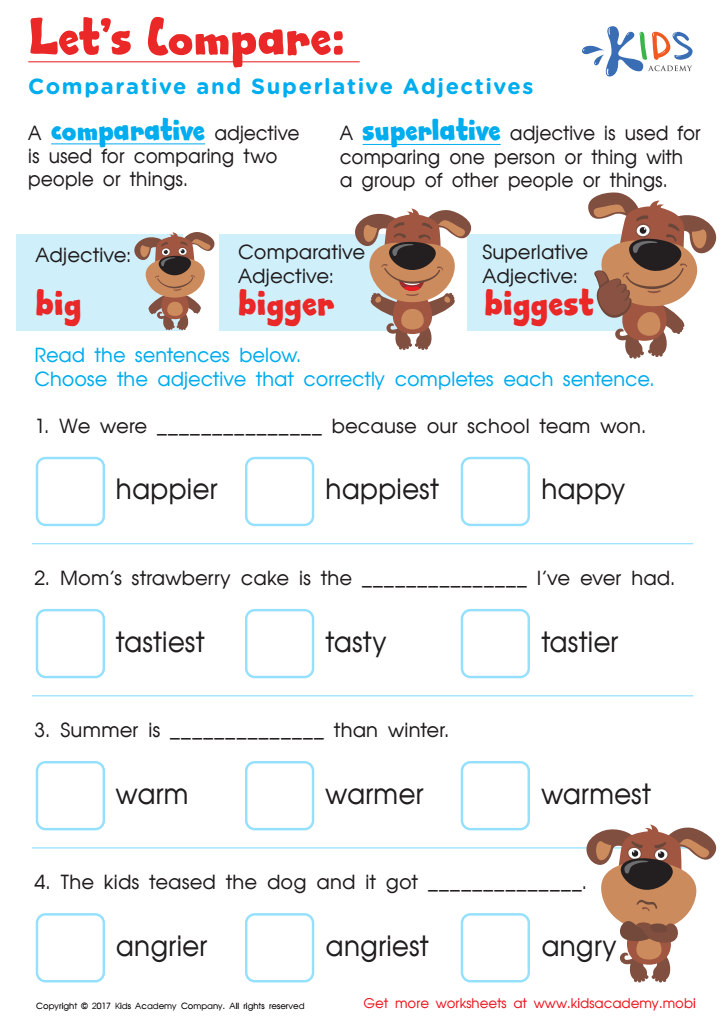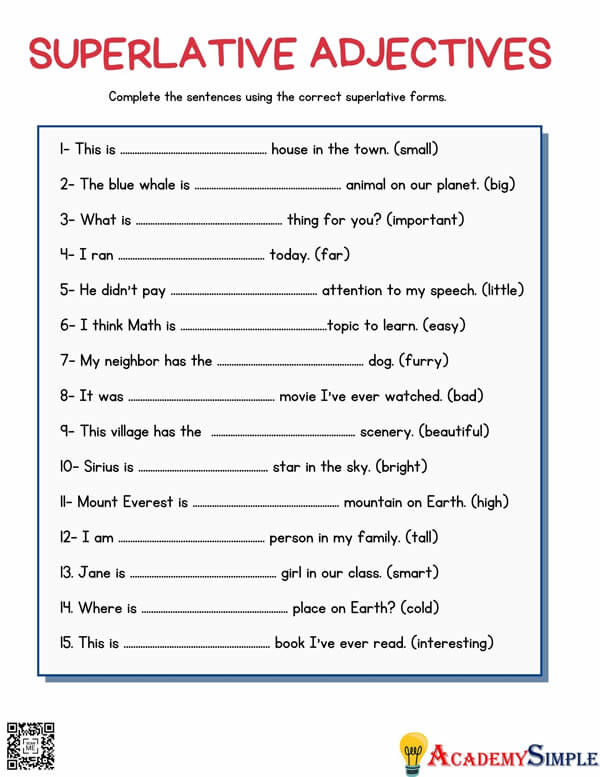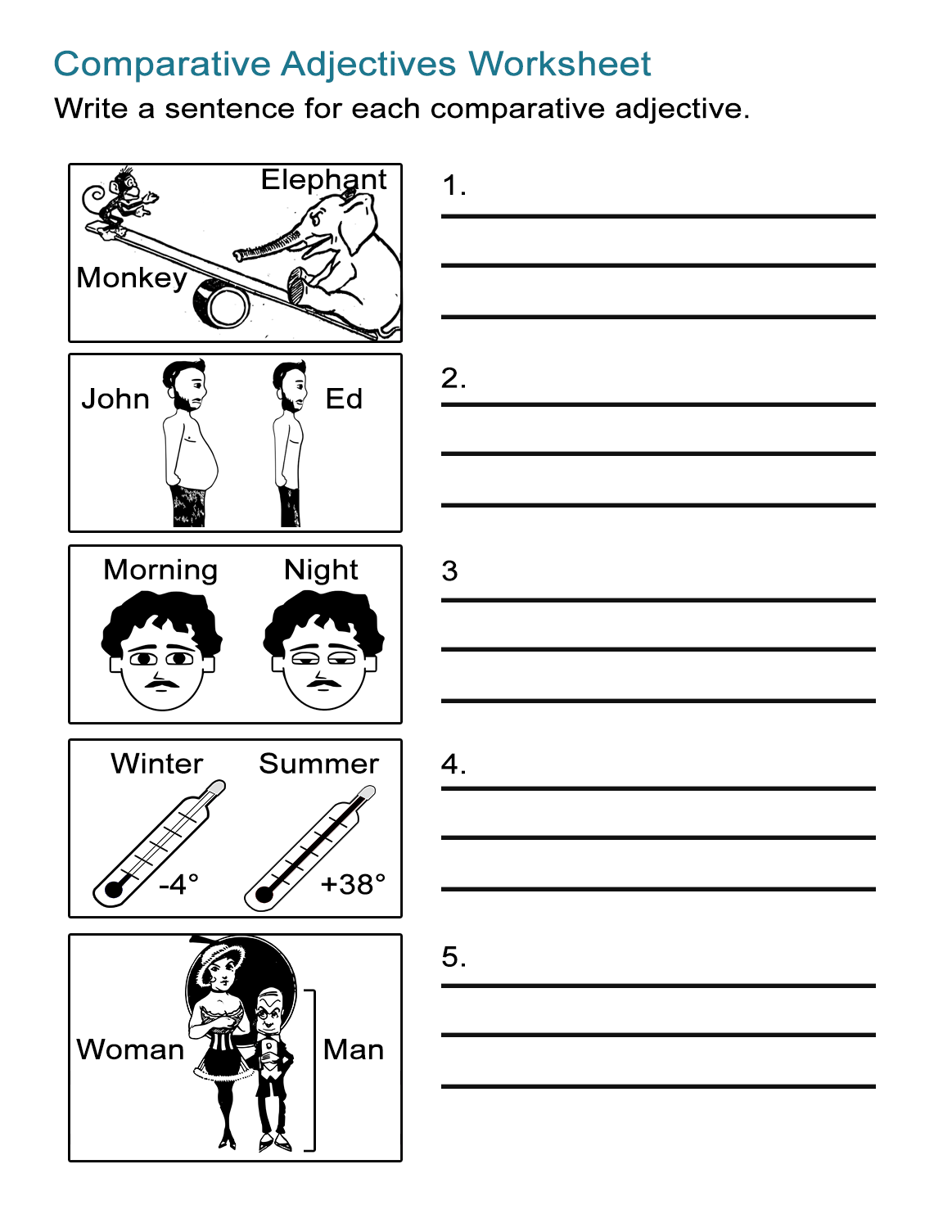
Crafting Effective Comparative and Superlative for EFL Worksheets: A Comprehensive Guide
The English language, with its vast vocabulary and intricate grammatical structures, often presents a fascinating yet challenging landscape for English as a Foreign Language (EFL) learners. Among the fundamental building blocks crucial for expressing nuance, comparison, and extremes are comparative and superlative adjectives and adverbs. Mastering these forms allows learners to move beyond simple statements, enabling them to describe differences, highlight unique qualities, and articulate preferences. To facilitate this mastery, well-designed comparative and superlative for EFL worksheets are indispensable tools for educators.
This article will delve into the pedagogical importance of comparatives and superlatives, explore the core grammatical rules, and, most importantly, provide a comprehensive guide to designing and implementing highly effective comparative and superlative for EFL worksheets. We will examine various worksheet types, discuss key design principles, and consider how these materials can be integrated into a dynamic EFL curriculum to foster both grammatical accuracy and communicative fluency.
The Significance of Comparatives and Superlatives in EFL

Comparatives and superlatives are not merely grammatical exercises; they are vital for effective communication. Without them, learners would struggle to:

- Describe Differences: Imagine trying to explain that one car is faster than another, or that one city is more crowded, without using comparatives. The language would become clunky and imprecise.
- Express Extremes: Superlatives allow learners to identify the highest, lowest, best, or worst of something. This is crucial for expressing opinions, making recommendations, and sharing observations about the world.
- Enhance Descriptive Power: By using these forms, learners can paint more vivid pictures with their words, enriching their narratives and descriptions.
- Engage in Debates and Discussions: Arguments and discussions often hinge on comparing and contrasting ideas, people, or objects. Comparatives and superlatives provide the linguistic framework for such interactions.
- Build Foundational Grammar: Mastery of these forms reinforces understanding of adjectives, adverbs, and sentence structure, paving the way for more complex grammatical constructions.



Therefore, providing ample, varied, and engaging practice through targeted exercises, especially through comparative and superlative for EFL worksheets, is paramount for EFL teachers.

A Brief Review of Core Grammatical Concepts
Before designing effective worksheets, a solid understanding of the rules governing comparatives and superlatives is essential. Worksheets should reflect these rules clearly and progressively.

Comparative Forms (used when comparing two items):
- Short Adjectives (1 syllable): Add "-er" (e.g., tall -> taller, fast -> faster). If ends in consonant-vowel-consonant, double the last consonant before "-er" (e.g., big -> bigger, hot -> hotter).
- Adjectives ending in -y (2 syllables): Change "y" to "i" and add "-er" (e.g., happy -> happier, noisy -> noisier).
- Other 2-syllable adjectives and all 3+ syllable adjectives: Use "more" before the adjective (e.g., modern -> more modern, beautiful -> more beautiful).
- Irregular Forms: good -> better, bad -> worse, far -> farther/further, little -> less, much/many -> more.


Superlative Forms (used when comparing three or more items and identifying the extreme):
- Short Adjectives (1 syllable): Add "-est" (e.g., tall -> tallest, fast -> fastest). Double consonant rule applies (e.g., big -> biggest). Always use "the" before the superlative.
- Adjectives ending in -y (2 syllables): Change "y" to "i" and add "-est" (e.g., happy -> happiest, noisy -> noisiest). Use "the".
- Other 2-syllable adjectives and all 3+ syllable adjectives: Use "most" before the adjective (e.g., modern -> most modern, beautiful -> most beautiful). Use "the".
- Irregular Forms: good -> best, bad -> worst, far -> farthest/furthest, little -> least, much/many -> most.
Worksheets should systematically address these categories, starting with simpler forms and gradually introducing more complex or irregular ones.
Principles of Effective Worksheet Design
The effectiveness of any comparative and superlative for EFL worksheets hinges on adherence to several core design principles:
- Clarity and Simplicity: Instructions should be concise, unambiguous, and in language appropriate for the learners’ proficiency level. The layout should be clean and easy to navigate.
- Gradual Progression (Scaffolding): Worksheets should follow a logical progression, moving from controlled, form-focused exercises to freer, meaning-focused tasks. Start with simple recognition and fill-in-the-blanks, then move to sentence creation, and finally to communicative activities.
- Variety of Task Types: Monotony is the enemy of engagement. Incorporate a diverse range of activities to cater to different learning styles and keep students interested.
- Relevance and Contextualization: Grammar should not be taught in isolation. Present comparative and superlative forms within meaningful contexts that resonate with learners’ experiences or interests. Use real-world scenarios, pictures, or short texts.
- Error Correction and Feedback Opportunities: Worksheets should allow for easy self-correction or teacher feedback. An answer key can be provided for self-study, or clear spaces for teacher comments.
- Engagement and Fun: Integrate elements that make learning enjoyable. This could include puzzles, games, creative writing prompts, or opinion-sharing activities.
- Differentiation: Consider learners with varying proficiency levels. Provide simpler versions for struggling students and more challenging tasks for advanced learners. This could involve varying the complexity of vocabulary or the length of sentences.
Types of Comparative and Superlative for EFL Worksheets
The cornerstone of any robust set of comparative and superlative for EFL worksheets is variety. Here are several effective types, ranging from highly controlled to more communicative:
-
Fill-in-the-Blanks / Sentence Completion:
- Description: Students complete sentences by inserting the correct comparative or superlative form of a given adjective/adverb.
- Example: "My brother is (tall) __ than me. Sarah is the (intelligent) __ student in the class."
- Benefit: Excellent for initial rule reinforcement and quick assessment of basic understanding.
-
Sentence Transformation:
- Description: Students rewrite sentences using a different comparative or superlative structure, or change a positive statement into a comparison.
- Example: "New York is a big city. London is also big. (Rewrite using ‘bigger’)." -> "London is bigger than New York." Or "No other student is as fast as Tom. (Rewrite using superlative)." -> "Tom is the fastest student."
- Benefit: Encourages deeper processing of the grammatical rules and their application in different contexts.
-
Picture-Based Comparison:
- Description: Provide images of two or more objects, people, or scenes. Students write sentences comparing or contrasting them using comparatives and superlatives.
- Example: Show pictures of three houses (small, medium, large) and ask students to write sentences like "House A is smaller than House B. House C is the biggest house."
- Benefit: Visually engaging, helps connect abstract grammar to concrete concepts, and encourages descriptive language.
-
Information Gap Activities:
- Description: Students work in pairs, each having incomplete information. They must ask and answer questions using comparatives and superlatives to complete their charts or descriptions.
- Example: Student A has information about three cities’ populations, temperatures, and costs. Student B has similar information but with blanks. They ask: "Is City X hotter than City Y?" "Which city is the most expensive?"
- Benefit: Promotes authentic communication, active listening, and spontaneous use of the target grammar.
-
Surveys and Interviews:
- Description: Students create questions using comparatives and superlatives (e.g., "Who is the oldest person in your family?", "What’s the most interesting hobby?") and interview classmates or family members. They then report their findings.
- Benefit: Highly communicative, personalizes the learning, and encourages real-world application of the grammar.
-
Debate and Discussion Prompts:
- Description: Present controversial or opinion-based statements requiring students to use comparatives and superlatives to justify their views.
- Example: "Which is better: living in the city or the countryside? (Use comparatives to explain why)." "What is the most important invention of the last century?"
- Benefit: Develops critical thinking, argumentation skills, and higher-level language production.
-
Creative Writing Prompts:
- Description: Ask students to write short stories, descriptions, or essays incorporating a specific number of comparative and superlative forms.
- Example: "Describe your ‘ideal’ holiday, using at least 5 comparatives and 3 superlatives." "Write about the funniest/scariest/most exciting experience you’ve ever had."
- Benefit: Allows for creative expression, solidifies understanding through application, and provides opportunities for extensive practice.
-
Error Correction Tasks:
- Description: Provide sentences with common errors related to comparative and superlative forms (e.g., "He is more taller," "She is the most beautifulest"). Students identify and correct the mistakes.
- Benefit: Develops metacognitive awareness of grammar, helps students internalize correct forms, and addresses common pitfalls.
Integrating Worksheets into a Lesson Plan
Worksheets are most effective when integrated thoughtfully into a broader lesson plan:
- Presentation: Introduce the grammar rules clearly, with examples.
- Controlled Practice (Worksheets): Begin with simpler fill-in-the-blank or transformation exercises to build confidence and accuracy. These are often the first comparative and superlative for EFL worksheets students encounter.
- Semi-Controlled Practice (Worksheets/Activities): Move to picture-based comparisons or short sentence-writing tasks, allowing a little more freedom.
- Freer Practice (Communicative Activities/Worksheets): Incorporate information gaps, surveys, debates, or creative writing where students generate their own sentences and engage in meaningful communication.
- Review and Assessment: Use short quizzes or additional worksheets to gauge understanding and identify areas for further practice.
Technology and Digital Comparative and Superlative for EFL Worksheets
The digital age offers exciting new avenues for creating and utilizing comparative and superlative for EFL worksheets.
- Interactive Platforms: Tools like Quizlet, Kahoot, or Google Forms allow teachers to create interactive quizzes, flashcards, and matching exercises that provide instant feedback.
- Online Worksheet Generators: Many websites offer templates or generators that can quickly create custom fill-in-the-blank or sentence transformation exercises.
- Digital Whiteboards and Collaborative Docs: Students can collaboratively work on comparative and superlative tasks, sharing ideas and correcting each other’s work in real-time.
- Authentic Materials: Integrating short video clips (e.g., comparing products in an advertisement) or online articles can provide rich, authentic contexts for comparative and superlative practice.
Digital worksheets can increase engagement, offer personalized learning paths, and provide immediate feedback, making the learning process more dynamic.
Addressing Common Challenges
Even with the best comparative and superlative for EFL worksheets, learners may face challenges:
- Over-generalization of Rules: Applying "-er/-est" to all adjectives (e.g., "more beautifuler").
- Solution: Consistent exposure to irregular and "more/most" forms, explicit rule reminders, and error correction exercises.
- Irregular Forms: Forgetting good/better/best or bad/worse/worst.
- Solution: Repetitive drills, mnemonic devices, and incorporating them frequently in various exercises.
- Spelling Changes: Forgetting to double the consonant (hotter) or change ‘y’ to ‘i’ (happiest).
- Solution: Specific mini-drills focusing on these spelling rules, highlighting them in examples.
- Lack of Context: Understanding the form but not when to use it.
- Solution: Always embed grammar practice within meaningful contexts, using pictures, stories, or real-life scenarios.
Conclusion
Mastering comparative and superlative forms is a significant milestone for EFL learners, empowering them to express complex ideas and engage in richer conversations. The strategic design and implementation of diverse and engaging comparative and superlative for EFL worksheets are fundamental to achieving this mastery. By adhering to principles of clarity, progression, variety, and contextualization, educators can transform potentially dry grammar drills into vibrant learning opportunities.
From basic fill-in-the-blanks to dynamic communicative tasks and leveraging digital tools, the future of comparative and superlative for EFL worksheets is bright. When thoughtfully crafted and integrated into a comprehensive curriculum, these essential teaching aids not only solidify grammatical understanding but also build the confidence and fluency necessary for learners to truly thrive in the English language.
